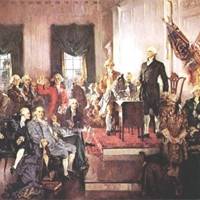The pivotal Constitutional Convention, a cornerstone event in American history, convened in Philadelphia, Pennsylvania. Specifically, delegates from various states gathered at Independence Hall (then known as the Pennsylvania State House) from May to September of 1787. This assembly was called to tackle the significant challenges arising from the inadequacies of the Articles of Confederation, the then-governing document of the newly formed United States. The convention’s ultimate outcome was the drafting of the United States Constitution, a document that fundamentally reshaped the American government and continues to be its bedrock.
 The United States Constitution document, a foundational legal text created at the Constitutional Convention in Philadelphia.
The United States Constitution document, a foundational legal text created at the Constitutional Convention in Philadelphia.
The Genesis of the Convention: Addressing the Weaknesses of the Articles of Confederation
The Articles of Confederation, adopted in 1777, established a weak central government with limited powers. This structure proved increasingly problematic, particularly in the realm of foreign policy and national governance. The central government struggled to enforce treaties and laws, as states often acted independently and in their own self-interest. A key example of this was the Treaty of Paris of 1783, which officially ended the American Revolutionary War. This treaty included provisions regarding debts owed to British subjects and the restitution of property to British loyalists. However, many states obstructed the enforcement of these clauses, leading to Britain’s refusal to vacate military forts on U.S. territory.
Further complicating matters, the Confederation Congress lacked the authority to regulate trade effectively. British goods flooded American markets, harming domestic businesses. Interstate trade was also hindered by states imposing tariffs on each other’s goods. Additionally, Spain’s control of New Orleans and the Mississippi River posed a significant challenge, as American ships were barred from navigating this crucial waterway. These issues, along with domestic problems like war debt, highlighted the urgent need for a stronger, more unified government, leading to the call for the Constitutional Convention in Philadelphia.
 Delegates gathered at the Constitutional Convention in Philadelphia in 1787 to address the shortcomings of the Articles of Confederation.
Delegates gathered at the Constitutional Convention in Philadelphia in 1787 to address the shortcomings of the Articles of Confederation.
Philadelphia: Setting the Stage for a New Nation
Philadelphia was chosen as the location for this crucial convention for several reasons. As a major city and the site of the Declaration of Independence, Philadelphia held symbolic importance and was geographically central, making it relatively accessible for delegates from all states. Independence Hall, with its rich history, provided a fitting and inspiring venue for the delegates’ deliberations.
The atmosphere in Philadelphia during the summer of 1787 was one of intense debate and deliberation. Delegates, including prominent figures like James Madison, Alexander Hamilton, and Benjamin Franklin, grappled with fundamental questions about the structure and powers of the new government. They debated various plans, most notably the Virginia Plan and the New Jersey Plan, ultimately leading to the Great Compromise which shaped the legislative branch.
Crafting the Constitution: Key Decisions and Compromises
The delegates at the Constitutional Convention in Philadelphia worked to create a balanced system of government. They established a framework based on the separation of powers among the legislative, executive, and judicial branches, incorporating checks and balances to prevent any single branch from becoming too dominant. Initially, the framers envisioned a strong legislature and a less powerful executive. However, as discussions progressed, the executive branch, led by the President, gained significant authority, particularly in foreign affairs.
The Constitution granted the President the power to conduct foreign relations, a crucial step in addressing the weaknesses of the Articles of Confederation. While treaty ratification remained with the Senate, requiring a two-thirds majority, this balance aimed to ensure both executive leadership and legislative oversight in international matters. This structure was a direct response to the challenges experienced under the Articles, where a lack of centralized authority hampered effective foreign policy.
Ratification and Legacy: The Constitution Takes Effect
Following the drafting of the Constitution in Philadelphia, the document was sent to the states for ratification. After securing the necessary number of state ratifications, the Constitution officially came into effect in 1789. One of the first actions of the new government was the creation of the Department of Foreign Affairs, which was soon renamed the Department of State. This department was established to manage the nation’s foreign policy, a function that had been severely lacking under the previous system.
The U.S. Constitution, born from the debates and compromises in Philadelphia, has served as the enduring framework for the United States government. Its creation at the Constitutional Convention marked a turning point in American history, establishing a more effective and unified nation capable of navigating both domestic and international challenges. The location, Independence Hall in Philadelphia, remains a powerful symbol of American democracy and the birthplace of the U.S. Constitution.

